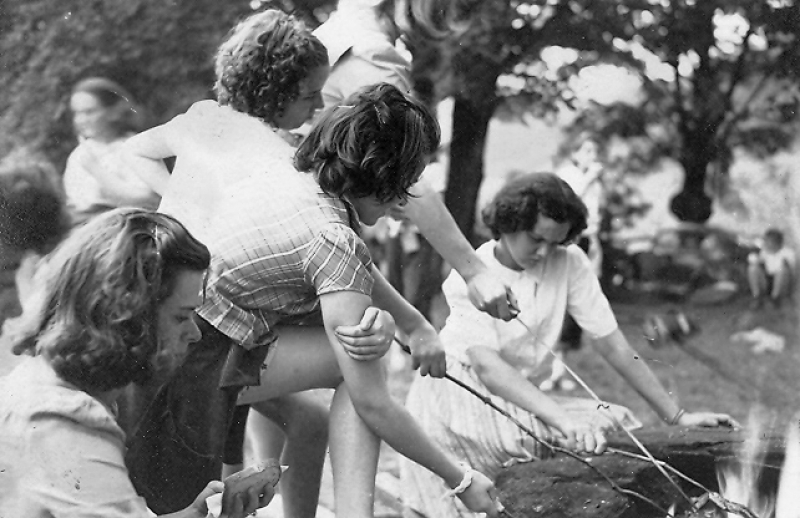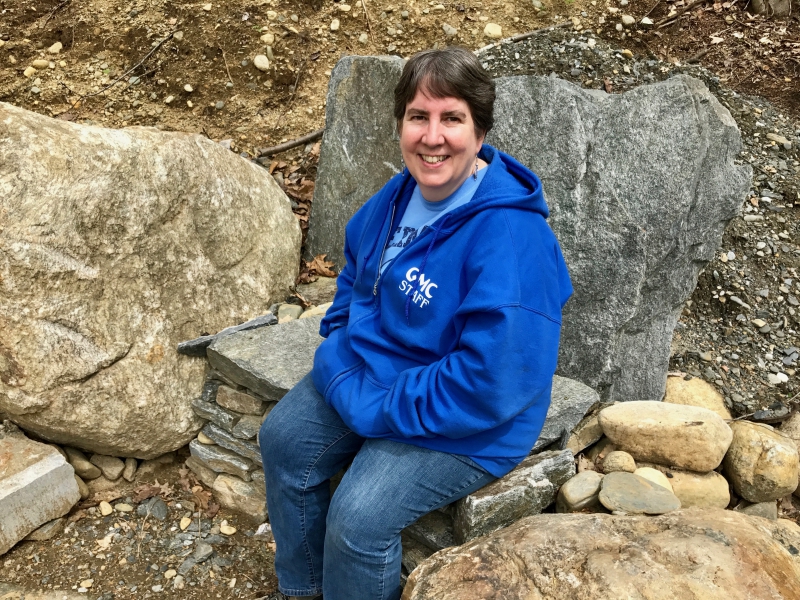By Joyce Marcel
It’s not every day that you hear of something that’s still going strong after 100 years. Especially not something for girls. And certainly not in the tiny town of Dummerston, Vermont.
But this summer, the Green Mountain Camp for Girls is celebrating its 100th year with reunions, shared memories, singing, feasting, dancing, sport, and yes, s’mores. It’s also mounting a Centennial Campaign to raise $100,000 for capital improvements.
The camp seems to inspire the girls who go there.
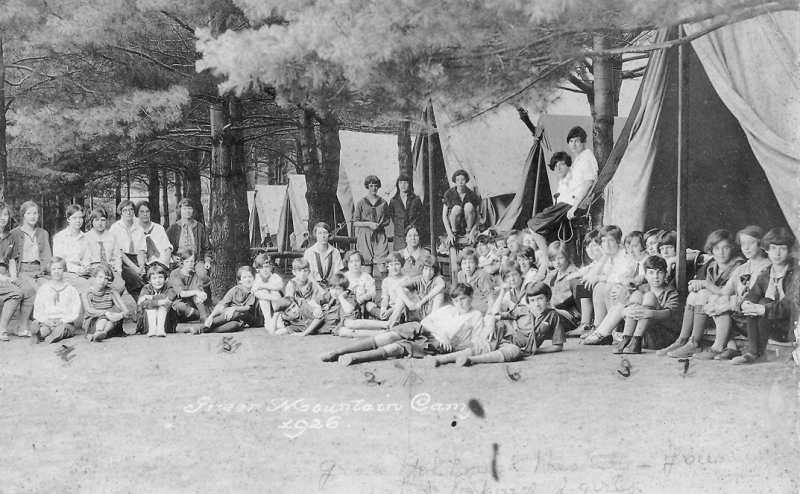 “We’re helping people recapture a very good time in their lives,” says current camp director, former GMC camper, and former counselor Billie Slade.
“We’re helping people recapture a very good time in their lives,” says current camp director, former GMC camper, and former counselor Billie Slade.
“People who live all over the country are making plans to come and meet other people from their sessions. Probably the oldest coming is in her 80s. I’ve had conversations with people who are 90 years old. I met a woman here who was here in the 1930s! Just the smell of the lodge was enough for her and she started singing ‘Always in the Moonlight.’ I can’t remember what I had for breakfast, but I remember that song as if it were yesterday. It’s our goodnight song. We all stand in a circle to sing it. It becomes a part of you,” Slade recalls.
The camp was begun by two teen-aged girls, Sarah Bradley and Grace Holbrook, in 1917, in response to a Thompson Trust study that concluded, contrary to popular belief, that rural children were not living healthier lives than their urban counterparts.
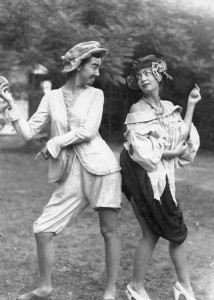 According to Richard Epstein, Bradley’s grandson and the current president of the camp’s board of directors, there was plenty for such a camp to accomplish at the time:
According to Richard Epstein, Bradley’s grandson and the current president of the camp’s board of directors, there was plenty for such a camp to accomplish at the time:
“Just imagine a rural family farm in Vermont in 1917. No highways and lots of hills and valleys which make getting around more difficult. So these farm family kids were really isolated. And they were worked hard. Grandmother and Grace Holbrook saw a need for girls to socialize, to get out of their isolated farms, to learn about one another, to sing songs, and have a fun time away from the chores of the farm. And to give them some kind of health education in the hope they might bring back some of the hygiene skills they learned at camp back to the farms.”
Epstein remembers his grandmother fondly. “She was a wonderful woman,” he says. “Her ancestry was very tied to Vermont. Steven Rowe Bradley was a Revolutionary War general. Another ancestor was William Czar Bradley. He surveyed and negotiated the Treaty of Ghent, which defined the border between Canada and the state of Maine and the U.S. So she came from a long line of Vermonters. Her father was Richards Merry Bradley, who was of some renown in Brattleboro. He was the first attorney for the Thomas Thompson Trust.”
The trust was founded to support poor sewing women who had made uniforms for Union soldiers in the Civil War. When that group died out, money was still left in the trust.
“My great-grandfather worked on making the trust have a new focus,” Epstein explains. “He did that by founding Brattleboro Memorial Hospital and the Thompson Nursing School. One of the things the trust did before 1917 was that study. So my grandmother must have been exposed to a certain amount of discussion about it.”
Backing happy campers
The camp runs seven one-week-sessions every summer. Girls can sign up for one, two, or more sessions. Sixty girls comprise a session. Last year the camp hosted approximately 275 girls. There is a robust scholarship program.
The camp has 20 full-time counselors during the season, plus a paid, full-time director. It uses about 15 volunteer counselors-in-training and another 35 volunteers who perform maintenance, repairs, beautification and much more throughout the year. It has become a center of community involvement as well as a summer retreat for girls.
Over the years the camp had its ups and downs. The most recent camp savior was Fran Lynggaard Hansen, who, like so many others, started as a camper and then continued working with the camp after she became an adult.
“She was known as Frankie Fairchild when she was a camper here,” Slade explains. “I really credit Fran for resurrecting the camp. There was a time in the early 2000s when only a handful of girls came. We had a different director every year. It was run down. Fran really turned the camp around.”
Hansen was camp director from February 2007 to August 2011. Reached in Kuwait, where she is teaching, she had a lot to say about the camp’s importance in her life:
“Green Mountain Camp for Girls has been an important part of my life since I was seven years old, and my story is not unique,” Hansen messaged us. “Back in the day when I was a camper, electricity had just been installed in the cabins and doors had just been hung. For the first time, there were screens in the windows. The beds were left over World War I bunks that were stuffed with fresh straw. As campers, we loved that it was a little like going back in time or visiting Grandma’s attic.”
Hansen’s big idea was to return the environment of the camp to its early days.
“It had faltered for many years trying to be different things to different people,” Hansen says. “I decided to bring back the type of programing that I had experienced as a child. Now an entirely new generation of girls are rediscovering their Vermont roots without the use of electronic devices and all the comforts that we are accustomed to today. They too are visiting their grandmother’s lifestyle and time period, and they love it every bit as much as I did when I was a child.”
‘I learned to do that here…’
Hansen remembers one camper, who attended in the 1920s or 1930s, who came back to visit.
“She stopped me one day as she walked into the hall and said, ‘It was right here,’” Hansen recalls. “I asked her what she meant and she grabbed my hand as we continued walking toward the fireplace without saying a word. She found the exact spot she was looking for, swung around, still holding on to my arm for support, then let me go, balanced her own arms and did a little soft shoe number she’d learned at camp and presented right on Talent Night all those years ago. Then she beamed as she told me, ‘I learned to do that here, at GMC, 76 years ago, and I still remember how!’”
Today the camp is one of a few opportunities created for girls only.
“The girl-only situation lends a freedom of expression that many have not experienced,” Hansen says. “There are no mirrors at camp. We get dirty. We’re incredibly active. We take risks and we try new things. In this day and age, children don’t always have the opportunity to play in the woods, or have a pickup game of volleyball. Kids today are so much more scheduled than they’ve ever been. A GMC camp experience slows the pace of life down. I remember expressing to counselors that they would notice kids becoming less programmed.”
Electronic devices are banned.
“About day three, I could count on the fact that someone would say something to me like, ‘Hey! Have you ever heard the birds sing in the morning? I didn’t know they did that!’” Hansen says. “Or they might mention the bullfrogs in the puddles or notice the wind in the pines at night. When we are hooked up to electronics, we miss the sounds and sights of nature.”
Centennial Stairs project is a solid way forward
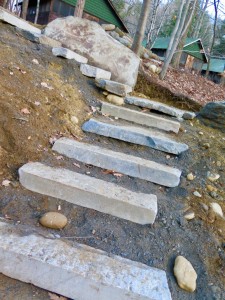 More than a landmark: The staircase, once a favorite link between the senior and junior levels of the campus, has been closed for several years due to erosion and the rotting out of wood steps. Our goal is to rebuild this staircase in stone with a design for safety, aesthetics, and durability. The staircase will be at the heart of the Centennial Projects not only because of its central location and function but also because it is the only project that is “ground-up” construction as opposed to a repair or augmentation.
More than a landmark: The staircase, once a favorite link between the senior and junior levels of the campus, has been closed for several years due to erosion and the rotting out of wood steps. Our goal is to rebuild this staircase in stone with a design for safety, aesthetics, and durability. The staircase will be at the heart of the Centennial Projects not only because of its central location and function but also because it is the only project that is “ground-up” construction as opposed to a repair or augmentation.
The design highlights our important anniversary in several ways. The staircase will “wander” up the slope (not a straight shot as the old one was). First, this is a safety issue. But it is also symbolic of our 100 years. Though the spirit and mission of the camp has remained remarkably true to its founding principles, we recognize the camp has had a journey over many years. Times change: Our campers and staff have come and gone. We’ve had lean years, less lean years, and some robust years. But in the end the upper landing and the lower landing will be in the same plane on the slope, linking our founding to our anniversary.
Along the way a camper will pass by 10 large boulders—each representing a decade of the camp’s history. As she goes up or down the stairs she will have to make choices. Some steps will divide into two paths around a boulder, a landing will offer a place to pause and sit on a bench or be moved through in favor of getting to the destination. The same will be true for some of the boulders, which will offer a perch. Though simple, the idea is participation in the process of moving from one place to another.
The lower landing will hold a special meaning. This landing will be one very large, flat Goshen stone. Two retaining walls will be built around the side of it that is against the slope. The stairs will start their ascent from the center of the back and the largest of the boulders will be there. The area faces south, perfect for the camp session group photos. Because of the many levels in this area (slab, retaining walls, boulder, stairs) no person in the photo should be blocked from the lens of the camera. When that photo is taken, with the Centennial Stairs as its setting, all those in the photo will be symbolically linked with all those who have come before. One century of the camp has been completed. The next century of the camp has begun.
Our goal is to have the Centennial Stairs built in time for the first group of campers in June, a.k.a. the first group of campers in our new century! —Green Mountain Camp for Girls


